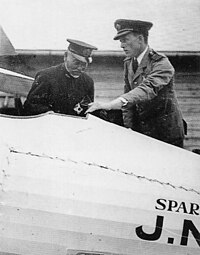William Forbes-Sempill, 19th Lord Sempill
|
The Right Honourable The Lord Sempill AFC |
|
|---|---|

Capt. Sempill showing a Gloster Sparrowhawk to Admiral Togo Heihachiro, 1921
|
|
| Born |
William Francis Forbes-Sempill 24 September 1893 Craigievar Castle, Aberdeenshire, Scotland |
| Died | 30 December 1965 (aged 72) |
| Nationality | United Kingdom |
| Education | Eton College |
| Occupation | Aeronautical engineer, pilot, diplomat |
| Years active | 1914–1941 |
| Organization | President of the Royal Aeronautical Society |
| Known for | Aviation Sempill Mission Spy for Japan |
| Predecessor | John Forbes-Sempill, 18th Lord Sempill |
| Successor | Lords seat: Ann Forbes-Sempill Baronetcy: Sir Ewan Forbes, 11th Baronet |
| Political party | Conservative Party |
| Spouse(s) | Eileen Lavery (1919-1935) Cecilia Alice Dunbar-Kilburn (1941-1965) |
| Children |
Ann Moira, June Mary (by 1st marriage) Janet Cecilia, Kirstine Elizabeth, Brigid Gabriel (by 2nd) |
| Awards |
Order of the Rising Sun, Japan Order of the Polar Star, Sweden. |
William Francis Forbes-Sempill, 19th Lord Sempill AFC, AFRAeS, (24 September 1893 – 30 December 1965) was a Scottish and record-breaking air pioneer who was later shown to have been a traitor who passed secret information to the Imperial Japanese military before the Second World War. Educated at Eton, he began his career as a pilot in the Royal Flying Corps and then served in the Royal Naval Air Service and Royal Air Force during the First World War. In 1921, Sempill led an official military mission to Japan that showcased the latest British aircraft. In subsequent years he continued to aid the Imperial Japanese Navy in developing its Navy Air Service.
In the 1920s, Sempill began giving military secrets to the Japanese. Although his activities were uncovered by British Intelligence, Sempill was not prosecuted for spying and allowed to continue in public life. The decision, which was taken at highest levels of government, was based on several factors. Firstly it would have revealed British successes in decoding Japanese communications and secondly he was part of the British Establishment with family links to the Royal Family. He was eventually forced to retire from the Royal Navy in 1941 after being discovered passing on secret material to Tokyo shortly before Japan declared war in the Pacific.
...
Wikipedia
